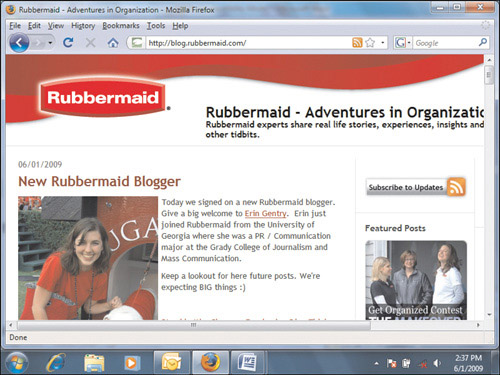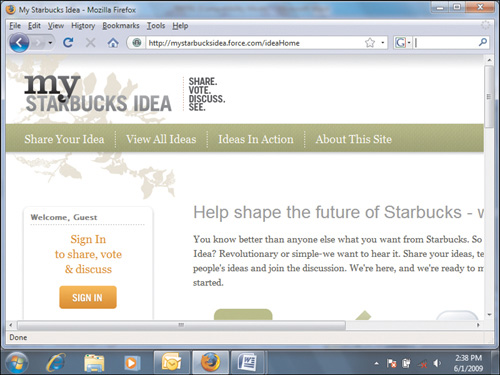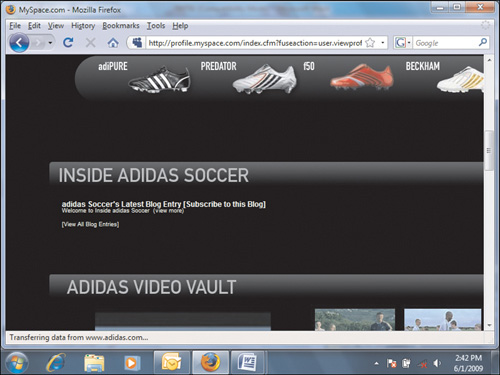1. Why Are Blogs So Important?
Media Growth Is in One Area: Online
With all the attention paid to the Web during the past decade and a half, you know that the Web has become, for many people, a preferred way to get information. This preference comes at the expense of more traditional media such as radio, television, and newspapers. For instance, at the time of this writing, the newspaper industry is contracting, and those in the newspaper/media business are openly wondering whether printed newspapers will even exist in 2020.
Improvements in computing technology and connection speeds have made traditional media content accessible on the Web as never before, and at prices that are reasonable or even free. Therefore, Eric dropped his package of TV, Internet, and phone access because he already had a cell phone, a mobile GSM card, and Wi-Fi for Web access, and he can get his favorite shows on video sites such as YouTube and Hulu.
In addition, many people are bypassing traditional media entirely and are reading content on the Web, and some are even creating content of their own. One popular way users create content is via a blog, which is short for Web log. You can integrate other technologies into a blog; for example, social networking functionality, your Web site, a hosted blogging Web site, such as WordPress, or a combination of these. (The next section considers these combos in more detail.)
And here’s the kicker: Online media is the only area of media currently growing. As?that growth accelerates, people are finding more and more different kinds of information online. Blogs are increasingly popular, too. In fact, Technorati (http://www.technorati.com), which tracks blogs, noted in its 2008 “State of the Blogosphere” report that more than 77 million unique visitors read blogs in the United States alone (see Figure 1.1).
Even so, these factoids don’t tell you why people, especially businesspeople, create blogs. So let’s start at the beginning: What is a blog good for, anyway?
Get the Message Out
A blog is an online journal that you can keep on your own Web site, house on a site specifically designed to host blogs (see Appendix A, “Important Blogging Sites,” for a list of the important ones), or produce on a social networking Web site such as MySpace that offers blog functionality. Like many computing technologies before it, blogging enables people to communicate with large numbers of people quickly and publicly. Bloggers may also produce and publish content anonymously (in case they want to write about hot-button issues, such as politics, without people learning their true identities). For example, one of Eric’s favorite blogs is the Halfway There blog shown in Figure 1.2; a friend of Eric’s, who uses the pseudonym Zeno Ferox, writes it.
Figure 1.1 The Technorati 2008 “State of the Blogosphere” report.

Figure 1.2 The Halfway There blog, written by Zeno Ferox.

Blog Popularity
People have been blogging since Web browsers became widely available in the mid-1990s, and blogs have steadily become more popular since then. A September 24, 2008 article on the Ars Technica Web site (http://arstechnica.com/old/content/2008/09/blog-growth-slows-more-bloggers-are-bringing-home-the-bacon.ars) illustrates just how quickly the number of blogs Technorati tracked between 2005 and 2008 grew. In 2005, the number was 8 million. In 2006, the number grew more than fourfold to 35 million. In 2007, the number of blogs more than doubled to 72 million. In 2008, Technorati reported it was tracking 133 million blogs. Technorati stopped tracking all blogs in 2009 to focus on English-only blogs as Technorati clained they didn’t have the resources to index and track non-English blogs; as a result, the true number of blogs in the blogosphere is unknown.
The Technorati 2008 “State of the Blogosphere” report identified how many users have blogs on the two largest social networking Web sites; as of 2008, Facebook had 41 million bloggers, and MySpace had 75 million. This difference in numbers might be because MySpace built blogging capabilities into its system early on in its development, whereas Facebook blogs were an add-on (and not too easy to find on the site as of this writing).
So, which blogs are the most popular? It depends on what source you use to measure blog popularity. Technorati lists its up-to-date top 100 blogs on its Web site by authority (that is, the number of comments posted on the blog, which notes the level of user activity) or by the number of fans who have bothered to vote for their favorite blog on the Technorati site. When we checked Technorati in early August 2009, the most popular blog site was the Huffington Post, shown in Figure 1.3 (http://www.huffingtonpost.com), a news and opinion Web site that had more than 18,000 comments on its various news stories.
According to a 2009 Google case study (http://www.google.com/analytics/case_study_huffington_post.html), the Huffington Post has surpassed 8 million unique visitors just in 2009 as of August 2009, which is considerable considering that the top 25 most popular blogs account for more than 10 percent of blog readership according to the ComScore Web traffic measurement firm (http://www.smartmoney.com/spending/rip-offs/10-things-your-blogger-wont-tell-you-20825/). However, Technorati considers the Boing Boing blog (http://www.boingboing.net) as the most popular blog because it has the most fans—that is, the number of Technorati readers who read it.
Hello, World!
So, how did businesses learn about the blog phenomenon? In many cases, employees talked about their own blogs. Employees kept track of what was going on with marketing and customers learned about blogging. And the mainstream media picked up on blogging, especially as people started turning to blogs such as Ars Technica (http://www.arstechnica.com) for technical news, as shown in Figure 1.4. All this information was passed along to C-level executives in the business, which in turn got businesses thinking about how they could make their businesses known in the blogosphere.
Figure 1.3 The Huffington Post site.

Figure 1.4 The Ars Technica Web site.

The Technorati 2008 report noted that dilettantes, who might write only once in a while (or on a whim), were writing fewer and fewer blogs. Instead, professional or corporate bloggers are taking over much of the blogosphere. These professionals write for money on blogging sites such as Ars Technica and may also perform other duties for a company (for example, an engineer or a marketing person, such as for the Intel Inside Scoop blog that we talk about in this chapter’s case study).
The professionalization of blogging has attracted advertisers who pay a price to have their banner ad on the blog. For example, Eric’s company blog might have a banner ad from the photographer he works with to help drive business to her company, and the photographer can also have a link on her Web site to Eric’s blog so that it benefits both companies. The 2008 Technorati blogging report noted that most bloggers accept advertising on their blogs, with a mean annual revenue of $6,000. Blogging sites that have more than 100,000 unique visitors a month can command much higher rates, with a mean annual revenue of $75,000.
You learn more about writing your blogs in Chapter 5, “Finding Topics to Write About,” and Chapter 6, “Who Will Write the Blog?”
Promote Products and Services
Blogging can be an additional income source, and perhaps even lucrative if you dedicate the resources necessary to build it up. But after you create your blog, what then? The most immediate use of a blog is to talk about your products and services. The conversation benefits not just your existing customers but also potential customers who might have questions about your company and its products/services.
If you offer general information and commentary about the state of your industry or profession, your blog can also highlight your expertise to the community at large. For example, suppose you use Rubbermaid products and want to get additional information about how to use them to organize your life more effectively. You can just go to the Adventures in Organization blog, shown in Figure 1.5. This blog discusses general organizational issues and problems and tips about how you can use Rubbermaid products to solve them from Rubbermaid personnel, guest columnists, and blog visitors who comment on blog posts.
If you’re looking for a good example of a blog that talks about a company’s services, visit the LinkedIn blog at http://blog.linkedin.com. It’s a great place to find information about what’s happening with the LinkedIn social networking service. That information comes from both LinkedIn customers and from guest authors. Figure 1.6 shows the LinkedIn blog page.
Figure 1.5 The Adventures in Organization blog, produced by Rubbermaid.

Figure 1.6 The LinkedIn blog site.

Reach People
Your business might have many audiences in addition to customers, such as suppliers, vendors, colleagues, and employees. Therefore, before you start writing your blog, identify whom you want to reach with it. You may find that a one-size-fits-all blog that tries to reach all potential audiences is a bad idea. If that’s the case, consider maintaining multiple blogs, each dedicated to a specifically identified audience.
For example, you can have a blog on your Web site that’s written for your customers. You can have another that lives on your intranet and is for the benefit of your employees. Chapter 3, “Creating a Blogging Strategy,” discusses blogging strategies in greater detail, and Chapter 7, “Getting Eyeballs to Your Blog,” explains how you get people to read your blog.
What type of blog (or the different types) you create also determines the level of personalization in the blog. For instance, you may want to make your customer blog more personal. After all, you want your customers to “connect” with your products and services, and you certainly want to make people feel that they can trust you. If you have a blog for your internal suppliers, however, you might not want it to be so personal.
You must also decide whether to allow comments on your blog (and if you do allow them, how to manage them). By default, blog sites let readers comment on blog posts, but the blog site owner can turn this feature off. For instance, you might want to have customers comment on your blog posts. In contrast, however, an internal supplier blog might be informational only, with no commenting functionality.
Suppose a blog reader has a question/comment. Most blogging platforms allow you to respond to that question/comment in a message thread that other readers can view. Sometimes people leave inappropriate comments, so you must moderate them. We consider the moderation issue and responsible blogging in Chapter 4, “Blogging Responsibly.”
![]() Note
Note
What is a “message thread,” anyway? This term refers to a sequence of responses to an initial message posted by someone about a specific topic or discussion. In the case of a blog, when someone comments on an original blog posting, that’s the first message in the thread. As you’ll learn about later in this book, you can not only comment about an original post but you can also comment about comments you read in a message thread.
Keep Pushing Content
Your faithful blog readers no longer have to go to your blog site to get your latest post (or to see whether you’ve posted recently). Instead, they can easily set up and use feed readers. Many blogging platforms allow people to receive your new blog posts automatically via the Really Simple Syndication (RSS) method. If you have a program with an RSS reader such as Microsoft Outlook, or if you go on the Web to view RSS feeds such as Google Reader, you can subscribe to your favorite blogs and be alerted when new posts are available. Chapter 2, “Leveraging Other Marketing Tools,” tells you more about subscribing to blogs and getting others to subscribe to?yours.
![]() Note
Note
Web designers and marketing people will tell you that you should update your Web site frequently. Their reasoning is that regular updates keep people coming back and search engines are always on the lookout for new content on sites. (If your Web designer or marketing people haven’t told you this, perhaps it’s time for you to look for new ones.)
Drive People to the Blog
Just because you build it, you can’t expect people will come to and comment on your blog. You’ve got to “say” something. If you can’t even think of something to say, what makes you think that others will have anything to add? Therefore, update your blog content at least every few days with new and interesting information about your company specifically or the industry in general. Search engines, especially Google, take particular interest in blog posts because they’re updated often and they usually include a lot of the keywords that you want Google to notice in your Web site. If one of your competitors is continually blogging about your industry and you aren’t, search engines will find your competitor’s blog and place it, not yours, high on the list of search results when someone searches for one or more terms in your industry.
You can also take advantage of other online and offline marketing tools that we discuss in Chapter 2.
Crowdsourcing
Blogs are helpful for keeping in touch with your customers and for finding out who your customers are and what they’re thinking about. For example, you can write a post that asks readers where they live, how they use your product, and what improvements they want in your product. They can then answer these questions in the comments.
You can even create a crowdsourcing blog. This term refers to asking readers of the blog for feedback so that the business can meet those customers’ needs as directly and immediately as possible. The optimal result is that customers will be happier and the business will see greater profit. Starbucks Coffee has done this to great effect with its My Starbucks Idea blog (see Figure 1.7).
Figure 1.7 The My Starbucks Idea crowdsourcing blog.

Starbucks put out the call to its customers both online and through stores to visit the blog site and provide suggestions for making Starbucks better. Visitors can also comment on others’ ideas and rate the popularity of the ideas. As of this writing, the number of popular ideas is 9,500. The end result is that Starbucks gets new sources of inspiration from the crowd at little to no cost and the blog invites a more engaged customer base.
Some businesses have been built around crowdsourcing. One example is InnoCentive (http://www.innocentive.com), shown in Figure 1.8. InnoCentive is a company that posts “challenge problems” in a number of areas, from engineering to math to life sciences to business. Their site opens with problems for anyone in the crowd to solve and promises cash prizes to solvers who meet the solution criteria. You can view the various challenges, solutions, and the latest news on the InnoCentive blog.
Figure 1.8 The InnoCentive site.

The challenge with crowdsourcing is critical mass. You need to get enough people to both respond to you and give you enough feedback that you can act upon. To help meet that challenge, we discuss in Chapter 2 other online and offline marketing tools that you can leverage with your blog.
Case Studies: Intel and Adidas
Like all marketing efforts, there are right ways and wrong ways to do things, and the same is true of blogging. In this section, we look at a more traditional blog from Intel that keeps you posted on the goings on at the chip maker. We also look at a blog that was added to the MySpace social networking site to reach potential customers, but failed to do so.
Intel Inside Scoop Blog
The Intel Inside Scoop blog (http://scoop.intel.com), shown in Figure 1.9, is a good example of a blog that gives you everything you’re looking for near the top of the blog (and the first few scroll downs). Having information at or near the top of the blog is important for usability’s sake because if your users don’t have to scroll down to find information, they will be happier with your blog and more inclined to come back.
Figure 1.9 The Intel Inside Scoop blog.

So, why might you want to emulate this blog when you create your own? There are a number of useful features on the blog, including the following:
• A menu at the top of the page takes you to specific sections (for example, bios of the people who write the blog and archives of past blog postings).
• The most recent blog post appears at the top of the page.
• You can readily see where you can subscribe to the blog feed.
• A Recent Posts area links to all the recent posts on the blog home page.
• A Blogroll area links to related blogs. In the case of the Intel Inside Scoop blog, the Blogroll area links to other Intel blogs and other companies’ blogs (for example, HP, Dell, and YouTube).
• In a Categories area, readers can view blog posts in areas of their interest.
• Connections link you to other social networking sites. This blog has links to Intel’s Twitter, YouTube, and Facebook sites and to pictures on the Flickr photo-sharing site.
Notice that the blog posts on the home page have embedded a variety of information in each one, including text, photos, and videos, such as the Intel LANFest at Intel’s Folsom facility, shown in Figure 1.10, which is near where Eric lives.
Figure 1.10 The Sacramento LANFest 2009 video embedded in a blog post.

This blog was built with Movable Type, a blogging platform you’ll learn about in Chapter 3. However, many of the features on the Intel Inside Scoop blog are also available in other downloadable blog platforms and from hosted services such as WordPress.com.
You can also post blogs on social networking sites to help reach your target audience more directly, but the rules of blogging still apply, such as updating your blog every few days (as the Intel Inside Blog scoop does), so that you don’t lose momentum, as we discuss in the next section.
Adidas Soccer MySpace Blog
Adidas serves as our second case study. Adidas, a large multinational shoe company, established a blog on its MySpace site to reach its young customers who frequent MySpace. (Adidas is headquartered in Germany but has its own page, and blog, on MySpace.) Adidas is a good example of the new model for creating brand value, but also proves that even large companies can botch the use of blogs when trying to create that value.
The Momentum Effect
One great online resource for social media marketing examples is the Being Peter Kim Web site (http://www.beingpeterkim.com/2008/09/ive-been-thinki.html). Peter Kim has compiled a number of social media marketing examples and resources.
One of those resources is a presentation that was made in 2007 by Rex Briggs, the CEO of Marketing Evolution. The presentation talks about what Rex calls “the momentum effect” (http://s3.amazonaws.com/thearf-org-aux-assets/downloads/cnc/online-media/2007-10-23_ARF_OM_Briggs_Nagy.pdf). Rex is an avid Adidas?fan.
The Briggs presentation discusses the old versus new models of creating value for a brand. You probably know about the business-to-customer (B2C) model of reaching consumers, such as paying for an advertisement in the local paper that will only reach a certain number of people (and hoping it will elicit some business). This is what Briggs calls the old model.
The new model is the customer-to-customer (C2C) model. In this model, each interaction is an impression. People are influenced to visit your community for one or more reasons. For example, a customer may have visited your MySpace page because he or she saw the link in your e-mail newsletter. In the case of Adidas, someone might have done an online search (Google or Yahoo!, for example) for the company and stumbled upon Rex Briggs’s profile, and contained in the profile is a link to the Adidas MySpace page.
With each potential customer interaction on the MySpace page as an impression, some of those potential customers pass along what they find to other users. Some of those users will visit your MySpace page and perhaps see more of what your company has to offer, and others won’t visit the page but will be positively influenced anyway and pass along the information about Rex Briggs and Adidas to others.
To get the most bang for your buck, the Briggs presentation recommends maximizing both B2C and C2C models. The B2C model requires advertising (such as an advertisement on MySpace) and integration with other offline marketing tools such as magazine advertising, and the C2C model brings people to your profile through links (such as from Rex Briggs’s MySpace page to the Adidas MySpace profile), referrals from one person to another, or someone who is self-directed.
So how does one take advantage of the momentum effect? It’s all about engaging the customer, and Briggs lists three tips for doing just that:
1. Make your brand a persona so people can identify with you.
2. Make your site (or blog) personal so that you give people a reason to talk about it.
3. Give the consumer a chance to realize a dream or fantasy.
You need to use all three tips to realize the momentum you seek.
Adidas Soccer Losing Momentum
Based on the Briggs report, we decided to visit the Adidas Soccer MySpace profile and see what it offers. The profile, which is shown in Figure 1.11, enables you to create your own photo of yourself with the team you support and its soccer gear (which you then can post on your MySpace page).
Figure 1.11 The Adidas MySpace page.

You can also download desktop wallpaper (that is, an image for your screen background) of your favorite soccer stars, add icons to your desktop (for example, get soccer icons to replace current icons on your desktop), and get product information about the latest shoes (which you can buy online from the Adidas Web site that pops up in a new browser window). You can also add Adidas to your group of friends, leave messages on the forum, view videos, and more.
All these activities give Adidas visitors a chance to tell their stories and interact not only with the company but also with fellow Adidas fans, who in turn spread the word about the Adidas MySpace page and help build the value of the Adidas brand. However, as you scroll down the page, it’s easy to overlook the Inside Adidas Soccer section directly below the featured shoes and directly above the Adidas Video Vault.
The Inside Adidas Soccer section is the place for Adidas blog entries, and there is only one entry: Welcome to Inside Adidas Soccer (see Figure 1.12).
Figure 1.12 The Inside Adidas Soccer section contains only one blog entry.

When you click the View More link (or the View All Blog Entries link), the blog page appears as shown in Figure 1.13. There is only one entry, dated Friday, April 25, 2008, which is more than a year ago as of this writing.
Figure 1.13 The Inside Adidas Soccer blog page.

The site states that “we’ve set up this blog to provide direct communication between you soccer players and fans” because Adidas wants to do “all we can to maintain our place as the top soccer destination on MySpace.” The blog invites readers to submit questions or comments for Adidas players and employees, and although 18 readers sent in comments, most between April 26, 2008 and February 3, 2010, there have been no responses to these questions or new blog entries posted since the April 25 introductory post.
For a company that has a strong presence on MySpace, the lack of a decent blog is a glaring weakness. What’s more, the Adidas Soccer site isn’t communicating with its customers as it promised, which makes the site less personal despite what they’ve done on the main profile page.
Although it’s impossible to tell how many people have visited the Adidas blog versus the Intel Inside Scoop blog, the much higher number of comments just on the first page of the Intel Inside Scoop blog suggests that Intel understands blog momentum and Adidas doesn’t, and that undercuts Adidas’s attempts to market and build its brand online.
Summary
Blogs have been rapidly growing in popularity to the point where blogs are no longer written by a home computer user but also by professional bloggers (those who do so for money) and by businesses that want to get their message out. Businesses use blogs to market their products, keep driving messages to their customers, and get customer feedback.
So how do you leverage your blog to ensure that it’s a valuable part of your overall marketing strategy? Let’s continue on to Chapter 2.
